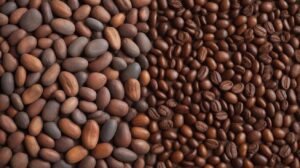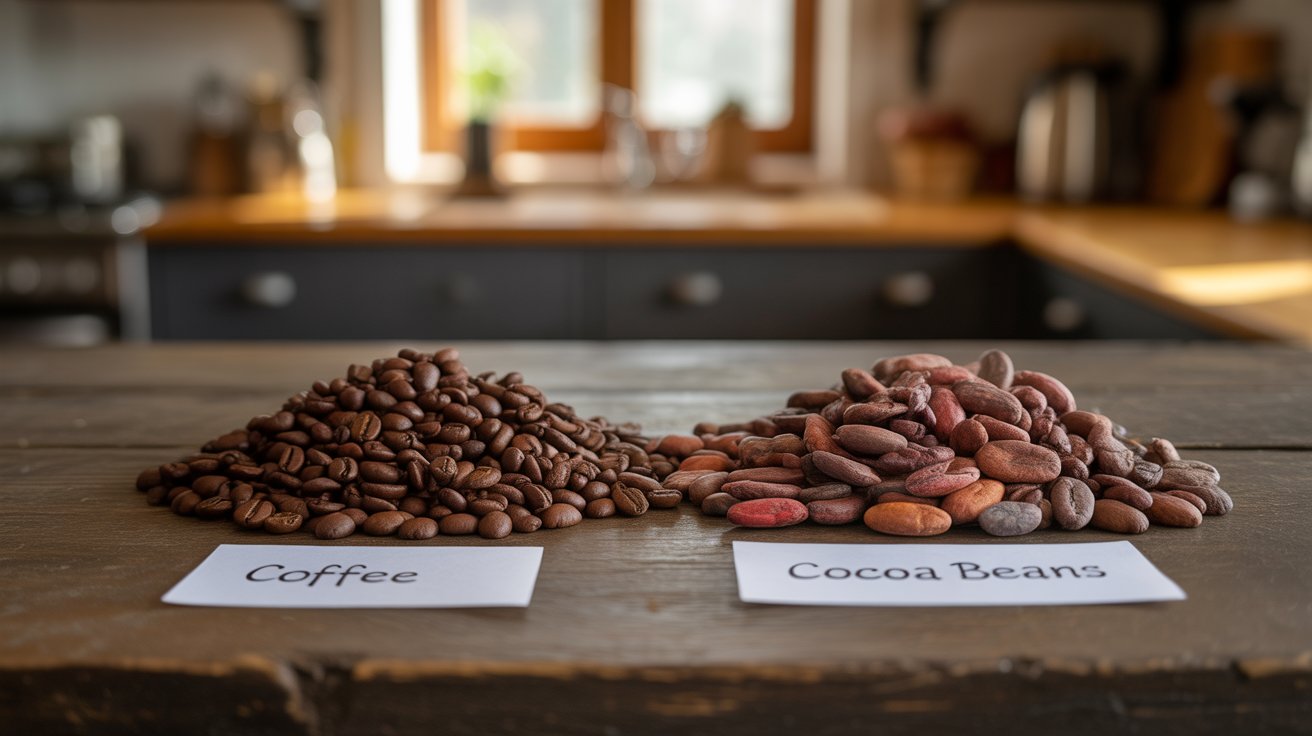Cocoa beans and coffee beans might look similar — but they fuel your body, brain, and brew very differently.
As someone who’s worked alongside bean‑to‑bar chocolatiers and specialty coffee roasters for over a decade, I’ve seen firsthand how much confusion exists around these two power-packed seeds. Especially in 2025, when more people than ever are asking:
“Is cocoa healthier than coffee?”
“Can I brew cacao like coffee?”
“Which gives a better energy boost — without the crash?”
This guide clears it all up.
You’ll get a full breakdown of cocoa beans vs coffee beans, backed by nutritional data, side-by-side brewing tips, and even a caffeine-vs-theobromine calculator to match your energy goals.
Whether you’re cutting caffeine, chasing antioxidants, or just curious if “choffy” lives up to the hype — I’ve got you covered.
Let’s settle the bean debate once and for all.
What Are Cocoa and Coffee Beans?
Cocoa beans and coffee beans may share a name, but they come from entirely different plants, climates, and chemical worlds.
If you’ve ever wondered why cacao feels “softer” while coffee hits like a jolt, the answer lies in their botanical roots and biochemistry. Let’s break it down.
Origins & Plant Taxonomy: Two Very Different Trees
Cocoa beans come from the Theobroma cacao tree — a tropical plant native to Central and South America. Think humid rainforests, shady canopy, and pods that look like footballs.
Coffee beans, on the other hand, grow on Coffea plants — mostly Coffea arabica and Coffea robusta. These thrive in higher altitudes, like the mountains of Ethiopia, Colombia, and Vietnam.
Key differences:
Cacao tree produces pods with 20–60 seeds (beans), wrapped in sweet pulp.
Arabica coffee is known for its mild, nuanced flavor; Robusta is more bitter and higher in caffeine.
Coffee beans are actually seeds from the cherry-like fruit of the Coffea tree.
So while both are “beans” in everyday talk, they’re from entirely separate species with very different farming needs.
Nutrient & Chemical Profile: Fat vs Buzz
Here’s where it gets juicy. Or oily.
Cocoa beans are about 50% fat — mostly in the form of cocoa butter. That’s why they’re so rich and smooth. Coffee beans? They only contain 10–15% fat, and that fat doesn’t extract well during brewing.
When it comes to what dissolves in water (aka what ends up in your drink):
Coffee beans release 18–22% water-soluble compounds, including caffeine and acids.
Cocoa beans? Less than 2%. That’s why brewed cacao is milder and less acidic.
Caffeine and theobromine stats:
Coffee contains around 1.2% caffeine by dry weight.
Cocoa clocks in at 0.1–0.7% caffeine, but shines in theobromine (1–3%) — a gentler, longer-lasting stimulant.
Translation? Coffee gives you a spike. Cacao gives you a cruise.
Sources:
Global Production & Sustainability: Two Stories, One Planet
Let’s talk scale.
In 2024, global production reached:
Cocoa: 5.8 million metric tons
Côte d’Ivoire produced nearly 38% of the world’s supply.
Coffee: 11 million metric tons
Top producers: Brazil, Vietnam, Colombia.
But there’s more than volume at stake — especially for cocoa.
Environmental & Ethical Impact:
Cocoa farming in West Africa is often linked to deforestation, illegal farming in protected reserves, and even child labor.
Cocoa trees thrive in shade, but many plantations use full-sun farming for higher yield — at the cost of biodiversity.
Coffee faces similar issues but has more robust certification systems (like Rainforest Alliance, Fair Trade).
Want to make a difference with your drink? Choose brands with transparent sourcing and certifications.
Sources:
Quick Comparison Table
| Feature | Cocoa Beans | Coffee Beans |
|---|---|---|
| Plant Species | Theobroma cacao | Coffea arabica / robusta |
| Fat Content | ~50% | 10–15% |
| Caffeine | 0.1–0.7% | ~1.2% |
| Theobromine | 1–3% | Minimal |
| Solubles in Brew | <2% | 18–22% |
| Top Producer | Côte d’Ivoire | Brazil |
| Key Risk | Deforestation, child labor | Deforestation, pesticides |
Bottom line?
Cocoa and coffee aren’t just different beans — they’re different experiences. From plant to palate, they deliver wildly unique profiles. And knowing the difference helps you make smarter, healthier, and more ethical choices.
Caffeine, Theobromine & Energy Type

Here’s the truth: coffee gives you a spike, cocoa gives you a cruise.
Coffee hits hard and fast thanks to caffeine. Cocoa takes the scenic route, powered by theobromine — a gentler, longer-lasting stimulant.
Let’s break it down:
Buzz Comparison Chart
| Beverage | Stimulant(s) | Typical Dose | Onset | Half-Life | Crash Risk |
|---|---|---|---|---|---|
| 1 shot espresso (30 ml) | 63–75 mg caffeine | Fast spike | ~30 min | 3–5 hrs | High |
| Brewed coffee (240 ml) | 95–120 mg caffeine | Strong | ~20–30 min | 4–6 hrs | Moderate to high |
| 30 g cocoa nibs (brewed) | 15–40 mg theobromine + ~10 mg caffeine | Mild | 45+ min | 6–10 hrs | Low |
| Ceremonial cacao (25–30 g paste) | 100–200 mg theobromine | Slow & steady | 45+ min | 7–10 hrs | Very low |
Takeaway: Coffee delivers a sharper buzz, but cocoa offers a smoother, longer energy arc — with far less crash.
Antioxidants, Flavanols & Disease Risk
Both beans are rich in antioxidants — just not the same kind.
Cocoa is packed with flavanols like epicatechin and procyanidins. These compounds are linked to:
Lower blood pressure (≈2 mmHg reduction in some studies)
Better cholesterol ratios (↑ HDL, ↓ LDL oxidation)
Improved nitric oxide flow — good for circulation
Coffee brings its own set of protectors:
Chlorogenic acids: known for antioxidant, anti-inflammatory effects
Diterpenes (cafestol & kahweol): may raise LDL unless filtered
So which is “healthier”? It depends.
If you’re caffeine-sensitive or focused on heart health, cocoa might win.
But if you want antioxidant punch plus mental alertness, coffee holds its ground.
Pro tip: Filter your coffee (paper filter > French press) to reduce diterpenes.
The Hidden Risks
Both beans can backfire if you’re not careful.
Cocoa is high in oxalates — compounds that may contribute to kidney stones, especially in people with a history of them.
Coffee’s acidity can trigger heartburn or GERD, especially in darker roasts or on an empty stomach.
Some ceremonial cacao also contains trace heavy metals like cadmium — always buy from a vetted source.
Sources:
Other Micronutrients & Shelf Stability
Let’s look beyond the buzz.
Micronutrient Breakdown (per 100g dry weight)
| Nutrient | Cocoa Nibs | Roasted Coffee Beans |
|---|---|---|
| Magnesium | 272 mg | 3 mg |
| Iron | 14 mg | 0.1 mg |
| Potassium | 500 mg | 49 mg |
| Sugar | 0 g (unsweetened) | Variable (roasted beans may be glazed) |
Cocoa’s high magnesium content is great for nerve and muscle support — especially for athletes or stressed-out folks.
Coffee beans, unless roasted with additives, aren’t major nutrient sources. You drink them for caffeine, not minerals.
Shelf Life & Storage Tips
Green coffee beans: 12–18 months if stored in a cool, dry, airtight container.
Roasted coffee: Best within 2–4 weeks post-roast. Stale = bitter.
Cocoa nibs: Up to 2 years sealed. They’re more stable due to low moisture and high fat content.
Ceremonial cacao blocks/paste: 6–12 months unopened; refrigerate after opening.
Store both away from light, air, and moisture. Think wine cellar, not kitchen counter.
Sources:
Bottom line?
Cocoa and coffee both deliver health benefits — but in very different packages.
Coffee amps you up. Cocoa nourishes and supports.
Choose your bean based on your goals — and don’t be afraid to switch it up depending on the day.
Read Also:
Flavor Profiles & Use Cases – When to Choose Cocoa vs Coffee
Here’s the quick answer: choose coffee for punch and clarity; cocoa for depth and comfort.
Both deliver bold, complex flavors — but their tasting notes, texture, and use cases couldn’t be more different.
Let’s dive in.
Tasting Wheel Breakdown
| Flavor Dimension | Coffee Beans (Arabica/Robusta) | Cocoa Beans/Nibs |
|---|---|---|
| Bitterness | Medium–High (esp. Robusta) | Low–Medium |
| Acidity | Bright, citrusy (Arabica) | Low–neutral |
| Chocolatey Notes | Rare (in light roasts) | Dominant |
| Body | Light to full | Thick, creamy (due to fat) |
| Aftertaste | Dry, often smoky | Smooth, lingering cacao |
Single-origin Arabica from Ethiopia may taste floral or tea-like.
Robusta from Vietnam? Earthy and bold — but rougher.
Cocoa nibs from Ecuador or Peru? Think deep chocolate with hints of red fruit or nutmeg.
- Use cocoa when you want richness, body, or a caffeine alternative.
- Use coffee when you crave clarity, energy, or a clean finish.
Brewing Methods — Step-by-Step
Want to get the most from your beans or nibs? Here are the top methods — no barista training needed.
1. “Choffy” Cold Brew (Cocoa)
Smooth, mellow, and low-acid — great summer sip.
Add 40g cocoa nibs to a mason jar
Pour 400ml cold water over
Steep in fridge 12–18 hrs
Strain using a fine mesh or nut milk bag
Serve over ice with oat milk or cinnamon
2. French Press Nib Brew
Closest to classic coffee with a dark chocolate twist.
Add 30g roasted cocoa nibs, coarsely crushed
Pour 250ml boiling water
Steep 5–6 min
Press slowly and pour
3. Moka Pot Cocoa-Coffee Blend
Bold hybrid with high body. Half-caffeine, double flavor.
Use 1:1 cocoa nibs to ground coffee
Fill bottom chamber with water as usual
Brew as for espresso-style moka
4. Ceremonial Cacao Latte
Deep, grounding, and energizing without the jitters.
Melt 25g ceremonial cacao paste in hot water or oat milk
Blend with pinch cinnamon, cayenne, or maca
Froth and sip slowly
Cost, Serving Yield & Formats
Cocoa tends to be pricier per gram, but offers richer yield per serving. Here’s how it stacks up:
| Product Type | Avg. Cost / 100g | Serving Size | Servings / 100g | Cost / Cup |
|---|---|---|---|---|
| Coffee Beans (roasted) | $3–6 | 10g | ~10 | $0.30–0.60 |
| Cocoa Nibs (roasted) | $5–10 | 30g | ~3–4 | $1.25–2.50 |
| Ceremonial Cacao | $8–15 | 25g | ~4 | $2–3.75 |
| Instant Blends (mushroom, adaptogen) | $10–20 | 5–10g | ~10 | $1.00–2.00 |
- Coffee wins for budget brewing.
- Cocoa delivers experience, depth, and wellness perks.
Common formats sold online or in stores:
Cocoa: Raw nibs, roasted nibs, cacao paste/blocks, powder
Coffee: Whole beans, ground, instant, mushroom or nootropic blends
Match your brew to your moment. Need clarity at 8am? Go coffee. Craving calm at 3pm? Go cocoa.
Trust & Authority (You Can See)
When it comes to comparing cocoa beans vs coffee beans, you deserve facts backed by real experts — not just flavor opinions or marketing claims.
Everything here is science-backed, expert-reviewed, and updated for 2025.
Peer-Reviewed Research & Official Data Sources
Cochrane Review (2024): Flavanol-rich cocoa linked to ~2 mmHg blood pressure reduction in adults
→ Read on Cochrane.orgUSDA FoodData Central: Nutrient profiles of roasted coffee, raw cacao nibs, and powders
→ Access USDA databaseICCO + EUDR Regulations: 2025 cocoa trade oversight under EU Deforestation Regulation (EUDR)
→ View EU official legislationBean Chemistry Studies:
Caffeine & theobromine comparisons
Chlorogenic acids vs flavanols
Post-harvest processing impact on antioxidant stability
→ [Example: Journal of Agricultural and Food Chemistry, PubMed IDs]
Cocoa vs Coffee Cheat Sheet
| Feature | Cocoa Beans | Coffee Beans |
|---|---|---|
| Caffeine (per 10g) | 10–70 mg | 90–120 mg |
| Theobromine | 100–300 mg | ~0 mg |
| Flavanols / Antioxidants | Epicatechin, procyanidins | Chlorogenic acids, diterpenes |
| Taste Notes | Chocolatey, nutty, earthy | Fruity, acidic, floral |
| Sustainability | ⚠️ West Africa = high risk | 🟢 Colombia, Peru = low risk |
| Cost per 10g dose | ~$0.45 (nibs) | ~$0.35 (whole bean) |
| Main use | Lattes, bars, smoothies | Espresso, drip, cold brew |
conclusion
You now know exactly how cocoa beans vs coffee beans stack up — from caffeine content and flavor profiles to sustainability and cost per brew. This isn’t just trivia; it’s practical insight for better choices in your daily ritual.
Want a smoother, mellow energy lift? Try cacao nib cold brew. Need bold flavor and a sharp jolt? Go with an Arabica pour-over.
Myth‑Busting & FAQs
Is cocoa healthier than coffee?
Not exactly — it depends on your goal.
Cocoa is richer in flavanols and magnesium, supporting heart health and mood.
Coffee has more antioxidants per cup, plus a stronger metabolic boost.
- Choose cocoa for calm focus and cardiovascular support.
- Pick coffee for energy, fat-burning, and sharper cognition.
Do cocoa beans contain more theobromine or caffeine?
More theobromine — and way less caffeine.
Cocoa: ~0.1–0.7% caffeine, 1–3% theobromine
Coffee: ~1.2% caffeine, almost no theobromine
Theobromine stimulates gently and slowly—no jitters, no crash.
Caffeine? Fast, sharp, and short-lived.
Can I make espresso from cacao nibs?
Not true espresso — but you can brew bold cacao shots.
Cacao nibs lack the soluble oils and fine particle size coffee needs for proper crema.
But you can:
Use nibs in a moka pot or aero press
Add coconut oil or cacao butter for extra body
Mix with coffee 50/50 for a hybrid “mocha-choffy” brew
Why does cocoa cause heartburn more than coffee?
The culprit is cocoa fat and flavanols.
Cocoa relaxes the lower esophageal sphincter (LES)
It also contains oxalates and acidity triggers
Coffee may irritate GERD too, but cocoa’s fat slows digestion, compounding the effect
Which bean is more sustainable: coffee vs cocoa?
Coffee (especially shade-grown Arabica) edges out cocoa.
Cocoa farming in West Africa is linked to deforestation and child labor
Coffee from Colombia, Peru, and Ethiopia tends to meet higher sustainability standards
Look for Fair Trade, Rainforest Alliance, or USDA Organic for both

Mahian has an insatiable curiosity for discovering unique coffee beans and exploring global café trends. He delves into the stories of coffee origins, packaging innovations, and the evolving landscape of café culture. Mahian’s contributions provide readers with a broader perspective on the world of coffee.

